
* As discussed in the previous chapter, development of the Sea Knight led almost immediately to the development of the scaled-up Chinook. The Chinook has proven an extremely popular helicopter and is still going strong in the 21st century. It also led to some one-off variants, such as the "Model 347", the never-completed "XCH-62 Heavy Lift Helicopter", and the "Model 360" advanced technology demonstrator.
* Following development and trials of the Vertol V-114 / YCH-1B, initial delivery of the production "CH-47A" Chinook to the US Army was in August 1962. The Chinook had a similar configuration to the Sea Knight, with the same contra-rotating tandem-rotor configuration and turboshaft engines mounted on each side of the rear rotor pedestal. As with the Sea Knight, a driveshaft ran up the top of the fuselage to the forward rotor, and one engine could drive both rotors in a pinch.
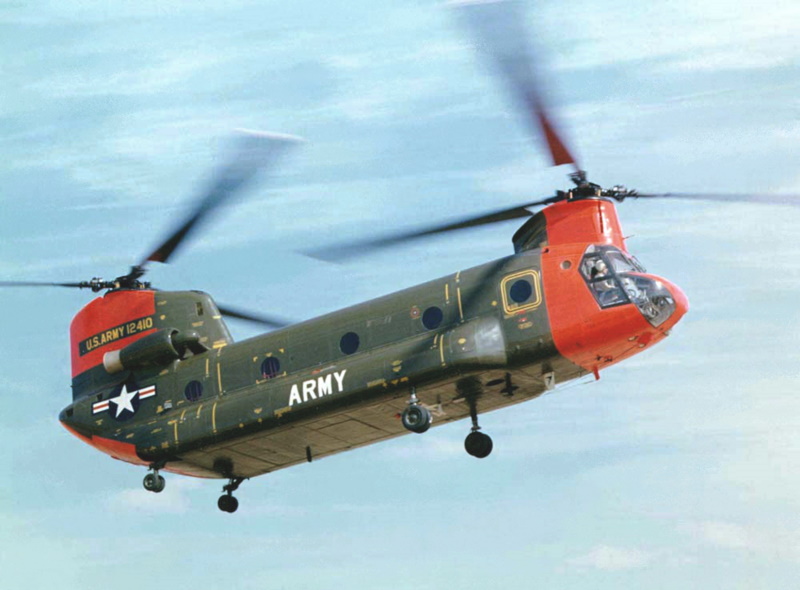
Initial CH-47A engine fit consisted of two Lycoming (now Honeywell) T55-L-5 turboshafts with 1,640 kW (2,200 SHP) each. These were soon changed in production to T55-L-7 turboshafts with 1,795 kW (2,650 SHP) each. The three-bladed rotors were set high enough to allow personnel to walk under them safely under normal circumstances. The rotors could be manually folded.
The Chinook had a rear loading ramp that could be set to any level to allow loads from truckbeds or other platforms, and which could be opened in flight for dropping paratroops or parachute loads. A winch system was provided in the cargo bay to help handle loads, which were secured with deck tie-point points. A single sling attachment was fitted in the belly.
Of course, the Chinook was bigger than the Sea Knight, boxcar-size instead of schoolbus-size. Fairings containing the fuel tanks ran most of the length of the fuselage, and there were four fixed landing gear, instead of three. Fuel capacity of the CH-47A's self-sealing tanks was 2,350 liters (621 US gallons). There were dual wheels on the front gear, which bore most of the load, and single wheels on the back. The rear wheels were steerable. As with the Sea Knight, the wheels could be fitted with skis for operation on snow or marshy ground. The machine could land on calm waters in an emergency.
Crew consisted of pilot, copilot, and loadmaster or combat commander. There were emergency exit doors on each side of the cockpit, and a split-section personnel door behind the cockpit on the left side. The personnel door had built-in steps on the lower half. An auxiliary power unit provided ground power and operations from remote sites, and the cargo bay included a heater-blower system to keep the occupants warm.
The CH-47A could carry 33 fully-equipped troops on sidewall seating -- more could be carried by fitting center seats; or 24 casualty litters with two attendants; or 2,720 kilograms (6,000 pounds) of internal cargo. Almost 6 tonnes (13,000 pounds) of cargo could be lifted externally, though with much reduced range for very heavy loads.
354 CH-47As were built for the US Army. The Chinook went to Vietnam in 1965, where it served with distinction, particularly in retrieving thousands of downed aircraft from field locations. It was also useful for carrying stores, ammunition, and artillery pieces to remote firebases. The Chinooks were generally armed with a single 7.62-millimeter M60 machine gun on a pintle mount on each side of the fuselage for self-defense, with stops fitted to keep the gunners from firing into the rotor blades. Dust filters were also added to improve engine reliability. At its peak employment in Vietnam, there were 22 Chinook units in operation.
* CH-47A production was followed by manufacture of 108 "CH-47B" Chinooks for the US Army, with initial flight of a prototype, a modification of one of the five original YCH-47A prototypes, on 9 September 1966. Initial service delivery was in May 1967, and the type arrived in Vietnam in February 1968. The CH-47B featured Lycoming T55-L-7C turboshafts with 2,125 kW (2,850 SHP) each, as well as slightly longer, redesigned rotor blades. Strakes were fitted alongside the rear loading ramp to improve flight stability, a feature retained in later Chinook models.
The CH-47B was an interim solution while Boeing worked on a more substantially improved Chinook, the "CH-47C", which featured Lycoming T55-L-11 turboshafts with 2,800 kW (3,750 SHP) each, along with a more robust power transmission system to support the increased power. One of the main drivers for the development of the CH-47C was that the earlier versions of the Chinook had troubles carrying the Army's M198 155-millimeter howitzer any distance. The CH-47C could not only handle the big howitzer, it also had substantially greater speed than its predecessors; in addition, the CH-47C had greater fuel capacity of 4,273 liters (1,129 US gallons). Fuel bladders could be installed in the cargo bay for long ferry flights, giving the C-47C the capability to cross the Atlantic and self-deploy to Europe -- though it seems likely that such long flights were extremely exhausting.
270 CH-47Cs were built, with the first flying on 14 October 1967. Initial deliveries to the US Army began in the spring of 1968, with the variant going into service in Vietnam in September of that year.
* The large Chinook fleet in US Army service would remain the backbone of the service's medium heli-lift capability, serving in most of America's military campaigns from Vietnam. Not only would the big helicopter prove useful and reliable, but it would also acquire an enviable flight safety record. It would prove adaptable to a wide range of roles, including fire-fighting with a sling-carried kit -- and even for transporting the Apollo Lunar Module, used to land on the Moon, from the Grumman manufacturing plant in Tulsa, Oklahoma, to Cape Canaveral in Florida.
The Chinook fleet was upgraded from early on. A glass-fiber rotor blade was introduced in 1969, and 182 CH-47Cs were retrofitted with the improved blades. The CH-47C fleet was also fitted with "crashworthy" fuel tanks beginning in 1973. 403 US Army Chinooks, including CH-47As, CH-47Bs, and CH-47Cs, were then upgraded to the "CH-47D" specification. The CH-47D featured:
Lift capacity was increased to 6,300 kilograms (13,900 pounds) internally or 10,340 kilograms (22,800 pounds) externally. The CH-47D could even lift a Cat D-5 bulldozer. One nice new feature was fit of three sling hooks, which made it much easier for the machine to lift unstable cargoes, or balance multiple loads. This was one of those ideas that in hindsight should have been implemented at the start; it became standard on all Chinooks.
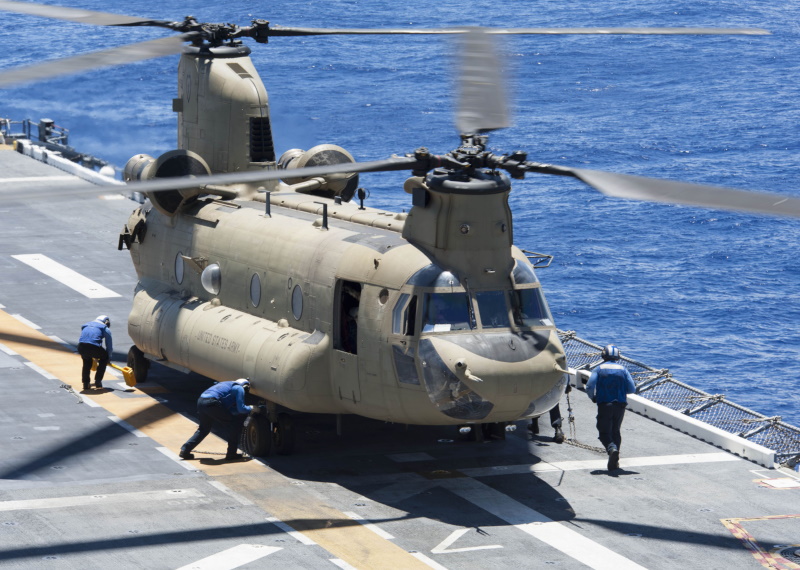
The CH-47D program was initiated in 1976, with first flight of a prototype on 14 May 1979. The first flight of a production CH-47D was on 26 February 1982, with the variant going into service that May. The CH-47D went on to provide excellent service in the Gulf War and other campaigns.
___________________________________________________________________
BOEING CH-47D CHINOOK:
___________________________________________________________________
rotor diameter:
18.29 meters (60 feet)
fuselage length:
15.54 meters (51 feet)
footprint length:
30.14 meters (98 feet 11 inches)
height (rotor head):
5.77 meters (18 feet 11 inches)
empty weight:
10,150 kilograms (22,380 pounds)
max loaded weight:
22,680 kilograms (50,000 pounds)
maximum speed:
298 KPH (185 MPH / 160 KT)
service ceiling:
6,735 meters (22,100 feet)
operational radius:
185 kilometers (115 MI / 100 NMI)
___________________________________________________________________
* About 32 CH-47Ds were updated to the "CH-47D Special Operations Aircraft (SOA)" configuration for support of the US Army Special Operations Command (Army SOC). These helicopters were fitted with:
Introduction to service was in 1985. The Army went on to obtain improved SOA Chinooks. The CH-47D SOA was followed by a dozen "MH-47D SOA" machines, with deliveries beginning in the mid-1980s. These rotorcraft were similar to the CH-47D SOA variant, but added:
The next step was the "MH-47E SOA", which built on the MH-47D by adding:
26 MH-47Es were rebuilt from other Chinook models, with initial flight of a prototype on 1 June 1990 and service delivery in early 1994. Two MH-47Es were lost in crashes, one in 1996 and the second in 2002. The CH-47D SOAs were returned to conventional Chinook transport configuration, but the MH-47Ds and MH-47Es remain in service.
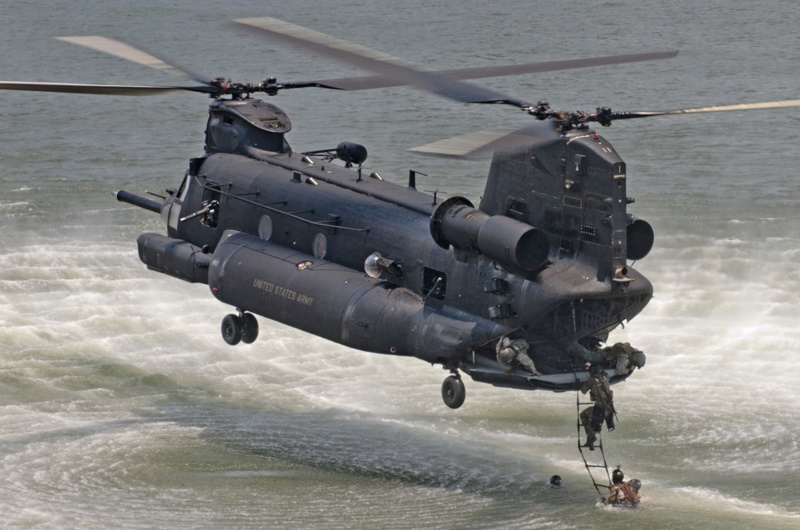
Following the American intervention in Afghanistan in late 2001, the US Army's special operations helicopter fleet was very heavily committed, and the service accordingly expanded the fleet, the new machines being designated "MH-47G SOA". They are current-production "CH-47F" Chinooks -- discussed below -- with MH-47E-style enhancements and an improved defensive countermeasures suite.
Initial delivery of an MH-47G was in 2004, with 44 MH-47Ds and 18 MH-47Es rebuilt to MH-47G standard, for a total of 62 upgrades. Eight new-build machines were also obtained, with deliveries in 2014:2015. 15 more new-build machines have been ordered, these MH-47Gs being built to an improved "Block 2" standard, with initial deliveries in 2021. The rebuilt machines are to be upgraded to modernized airframes, using machined metal assemblies instead of sheet metal.
BACK_TO_TOP* Boeing announced the "Model 234 Commercial Chinook" in the summer of 1978. This variant was based on the CH-47C but incorporated features that would go into later military Chinook production, such as a "long nose" housing weather radar; some were also fitted with oversized fairings for housing bigger fuel tanks. The Model 234s were powered by Lycoming AL-5512 turboshafts with 3,040 kW (4,075 SHP) for take-off, and could be ordered in pure airliner, cargo carrier, or mixed configurations.
The major target market for the Model 234 was support of offshore oil exploration. Six "Model 234LR" machines with the big fairings and airliner seating for 44 passengers were sold to British Airways Helicopters to support a contract from Shell Oil. However, the Model 234 suffered a serious blow to its credibility for offshore use when one was lost in 1986 due to a rotor transmission failure, with 45 people killed. BA then retired the Model 234.
Three more Model 234LRs were sold to a Norwegian operator. All the eight surviving Model 234LRs were eventually bought up by an American operator and brought up to the "Model 234UT (utility)" configuration, with increased lift capacity and additional fuel storage.
Two new-build "Model 234ER (extended range)" machines, similar to the Model 234LR but with additional internal fuel tankage, were sold to Arco Alaska. This gave total Model 234 production of only 11 machines, trivial in contrast to the hundreds of military Chinooks sold. Nobody has yet been able to sell a large helicopter on the commercial market.
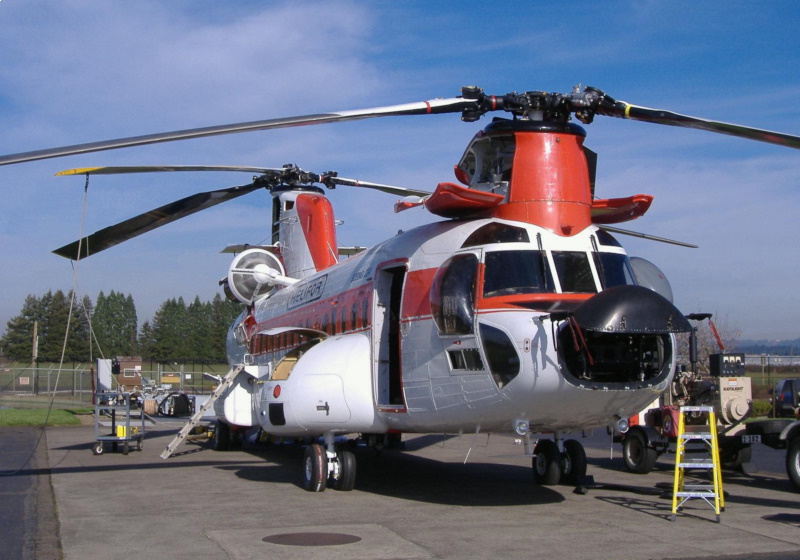
Some retired military Chinooks have ended up in civilian hands. Unical Aviation of California obtained a dozen retired CH-47Ds and refurbished them for air-tanker / wildfire operations, fitting them with an 11,370-liter (3,000 US gallon) retardant tank and dispersal kit, along with a glass cockpit. The first conversion entered service in 2019. These "helitankers" are operated in a collaboration with Coulson Aviation USA. A number of Model 234s and CH-47Ds were also obtained by Columbia Helicopters, which holds type certificates for the type. They were fitted with dual internal tanks for fire-fighting, though they could also carry a Bambi bucket.
* Although a number of ex-US Army CH-47As were provided to Thailand, the first new-build military export version of the Chinook was the "Model 414", essentially a CH-47C, with a dozen sold to Royal Australian Air Force (RAAF) and initial delivery in 1973. These machines were nicknamed "Chooks", Aussie slang for "chicken".
One RAAF CH-47C was lost in a crash in 1985. The other eleven were put into storage in 1989, when the Australian Army took up the battlefield support role from the RAAF. Seven of these machines found their way eventually back to the US Army, as part of a deal in which the other four were updated to CH-47D standard and returned to Australian Army service, where they were desperately needed.
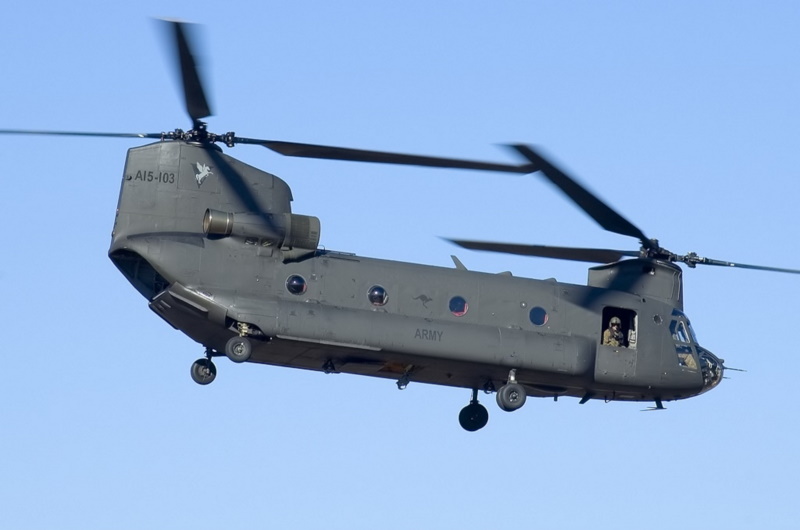
The Australian Army couldn't get enough out of their small fleet of Chinooks, and so two more CH-47Ds were ordered, with delivery in 2000. Following the loss of an Aussie Chinook in Afghanistan in 2011, two more CH-47Ds were ordered in 2012, these being refurbished US Army machines. While CH-47D configurations tend to vary in detail from customer to customer, the Aussie Chooks were almost identical to US Army Chinooks in order to ensure logistical compatibility.
* Canada bought nine CH-47Cs as "CH-147s", with deliveries in 1974. These machines were fitted with a power hoist above the crew door, a configuration referred to by Boeing as the "Super C". They were often fitted with skis. Two of these machines were lost in crashes, while the others were withdrawn from service in the early 1990s for cost reasons. In 2008, faced with operational commitments in Afghanistan, the Canadian Armed Forces obtained six refurbished CH-47Ds.
The Netherlands bought all seven of the surviving Canuck CH-117s, upgraded to CH-47D standards, and bought six more new-build CH-47Ds that were delivered in 1995, for a total of 13. The Dutch CH-47Ds featured a number of improvements over US Army CH-47Ds, including a long nose for Bendix weather radar, a "glass cockpit", and T55-L-714 engines with 3,065 kW (4,110 SHP) plus "Full Authority Engine Control (FADEC)". FADEC did not increase engine power as such, the engine mechanics remained essentially the same, but it made the engine "smarter" -- more responsive, efficient, and reliable, while requiring less attention from the pilot.
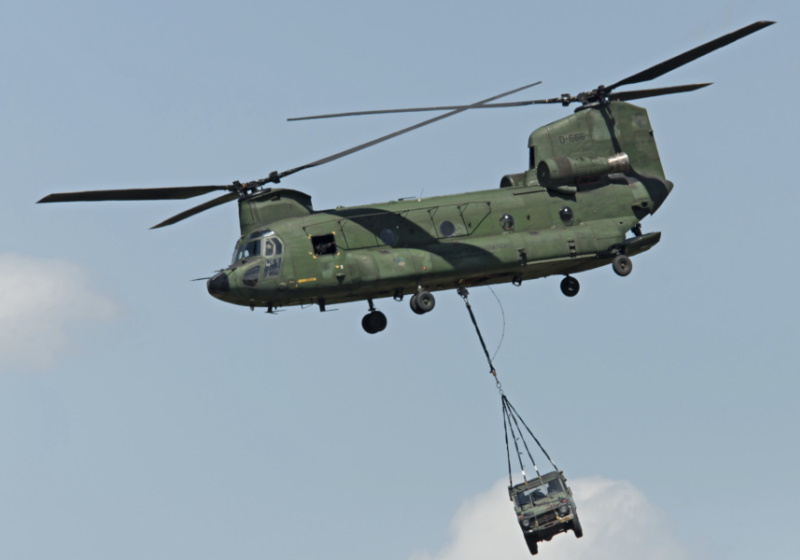
Argentina bought three CH-47Cs, with one being captured by the British during the Falklands War in the early 1980s. The other two, at last notice, remain in service for Antarctic support. They have been updated to the long nose weather radar configuration.
Spain bought a batch of 13 CH-47Cs under the designation of "HT.17". Nine of these machines were later updated to CH-47D standards, and the Spaniards also bought six new CH-47Ds.
* The British have been particularly enthusiastic users of the Chinook. In the early 1960s, British forces operated the Bristol Belvedere tandem-rotor helicopter, but the Belvedere was one of the less-loved British helicopters, and in 1967 the British Ministry of Defense decided to adopt the Chinook as a replacement.
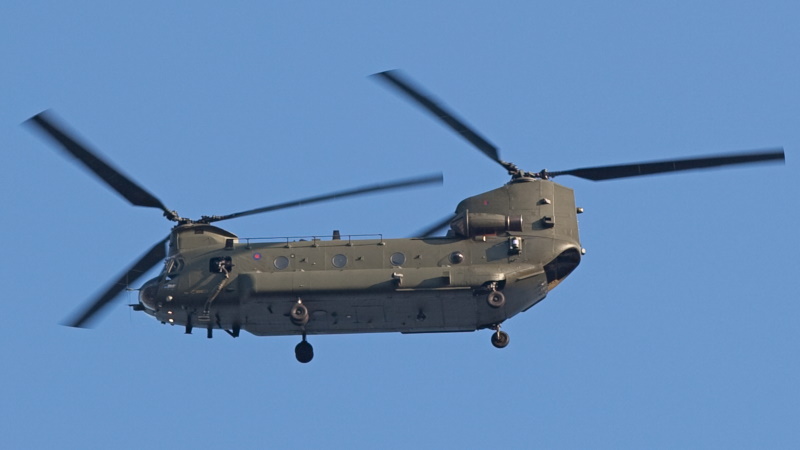
That was during a long and painful period of time when British defense procurement exercises tended to go more wrong than normal -- and defense procurement tends towards the troublesome to begin with. It wasn't until 1978 that the Royal Air Force (RAF) finally ordered 33 "Chinook HC1s", with initial flight of this variant on 23 March 1980 and introduction to service in the summer of 1981. This initial batch of RAF Chinooks featured Lycoming T55-L-11 turboshafts, as per the CH-47C, but included a number of advanced features not found on other CH-47C subvariants, such as:
Many of the improvements introduced in the HC1 found their way back into the US Army CH-47D upgrade. The HC1s were also field-fitted with pintle mounts for 7.62-millimeter M60 machine guns, and Marconi radar warning receivers (RWRs) salvaged from Avro Vulcan bombers.
Eight more HC1s were delivered to the RAF from 1984 to 1986, bringing the total to 41. Despite the fact that the designation was unchanged from the original batch, these machines had the Lycoming T55-L-712 engines of the CH-47D and an automatic fire extinguishing system. The older HC1s were upgraded to this specification,
The HC1s were also refitted with fiberglass rotor blades, to be redesignated "HC1Bs". Still later, in the early 1990s Boeing gave them a more comprehensive upgrade along the lines of the full CH-47D specification, turning them into "HC2s". The engines were rebuilt to the T55-L-712F standard, with FADEC. There were some initial problems with the FADEC software -- but they were quickly resolved, and the HC2 upgrade otherwise went well. Some of the machines were also brought up to "HC2A" specification, featuring a strengthened forward fuselage with provision for fit of a midair refueling probe.
HC2s had countermeasures kit, and could be fitted with a pintle-mounted 7.62-millimeter M134 Minigun Gatling gun firing out either side of the machine, plus a pintle-mounted 7.62-millimeter machine gun firing out the rear ramp. An auxiliary fuel tank could be carried in the cargo bay.
One British Chinook, designated "Bravo November", did outstanding service in the Falklands during the war there in 1982, even lifting 81 troops on one occasion. The British Chinooks later gave sterling service in the Gulf War and the Balkan campaigns in the 1990s.
* The RAF ordered eight more Chinooks in 1995. These "HC3s" were for special operations or combat SAR. They were to incorporate features from the US Army MH-47Es, such as large fuel tanks, midair refueling, and enhanced avionics, but they were based on the latest "Super D" AKA "CH-47SD" Chinook specification, described below. They were all delivered in 2001 -- only to fail operational qualifications, with the result that they were mothballed while the authorities tried to figure out what to do with them.
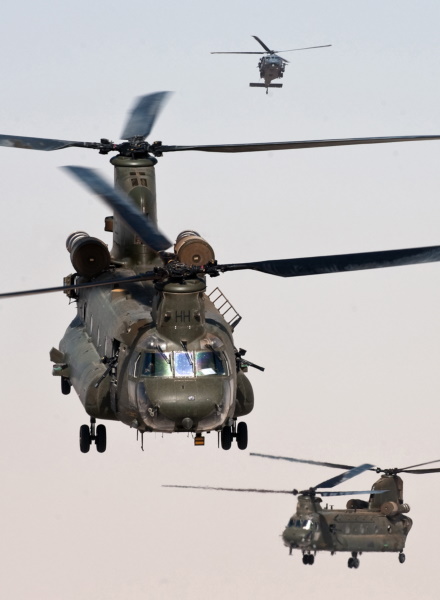
The problem was apparently that the contract was poorly written, failing to properly reflect service requirements. After several years of trying to fix things, the conclusion was to yank most of the advanced features of the HC3s and introduce them as HC2s, with the machines going into service from 2009.
In the meantime, in 1998 an upgrade program was initiated to bring the HC2/2A machines up to an improved spec, the focus being on operations in Afghanistan. The primary goal of the program was to provide a digital flight deck to support night and all-weather operations. The new cockpit was codenamed JULIUS, with Boeing as the prime contractor and Thales providing the cockpit avionics, based on the "TopDeck" system and featuring four 15 x 20 centimeter (6 x 8 inch) color displays. The upgrade also included:
The defensive countermeasures scheme was similarly updated under Project BAKER, while the communications system was updated under Project BENIC. All surviving Chinooks -- 46 machines, somewhat ironically including the eight HC3s "downgraded" to HC2 -- were updated. Updated HC2s were redesignated "HC4"; HC2As, "HC4A"; and HC3s, "HC5". The first of these modernized Chinooks was redelivered in 2010, the program now being complete. More recently, an update program was begun to give the fleet an "Airborne Collision Avoidance System (ACAS)", with redeliveries still in progress at last notice.
* The main license builder of the Chinook has been Elicotteri Meridionali (EM) of Italy, part of the Agusta helicopter group (and now part of AgustaWestland), which signed an agreement with Boeing for production of the CH-47C in 1968. EM built 38 CH-47Cs for the Italian Army, 26 of which were later upgraded to the "CH-47C Plus" standard with fiberglass rotor blades and the CH-47D's T55-L-712 engines. One was configured as a flying surgical operating room. The Italian Army had some interest in updating a set of their Chinooks to a special-operations configuration, like the US Army MH-47s; it is unclear if anything was ever done.
EM eventually built about 200 Chinooks. Besides Italy, EM Chinooks were obtained by a number of other nations:
* Following CH-47C exports, Boeing went on to market new-build "Model 414 CH-47D International Chinooks". The company wanted to conduct export sales of the new model themselves and did not sign a license agreement with EM, but did sign such an agreement with Kawasaki to permit production of the type for Japanese military requirements as the "CH-47J".
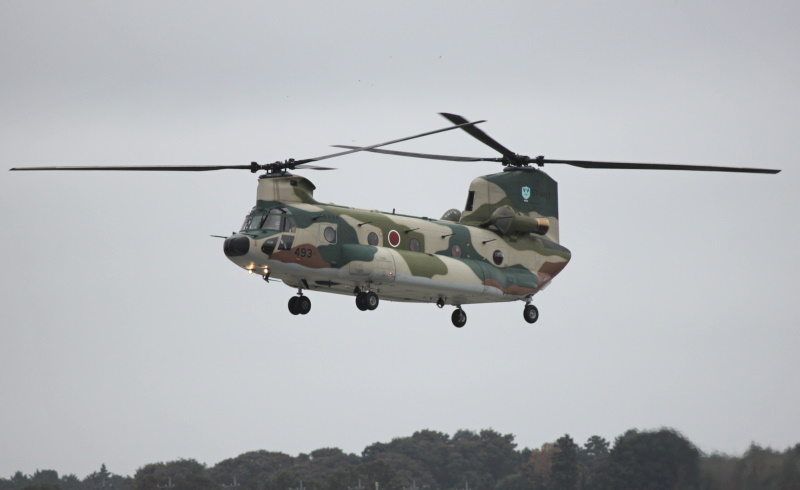
Kawasaki obtained two as pattern machines in 1986, and then assembled five from kits supplied by Boeing. Subsequent production was entirely built by Kawasaki, with 100 produced in all by 2017. Later production of JGSDF Chinooks has been to "CH-47JA" standard, with the machines fitted with enlarged saddle tanks, nose radar, an AN/AAQ-16 FLIR in a turret under the nose, and a partial glass cockpit.
There were other International CH-47D sales:
* The Chinook shows no signs of fading out of service, making it one of aviation's major success stories. CH-47Ds have been updated for the 21st century in the form of the "Model 414-100 CH-47SD Super D" for export, and the "CH-47F" for the US Army.
The CH-47SD was powered by twin T55-L-714A turboshafts, with 3,040 kW (4,075 SHP) each. These engines featured FADEC and improved fuel economy, as well as corrosion protection for operation in a salt-water environment. External cargo load was increased to 12,700 kilograms (28,000 pounds) on the center sling hook, or 9,070 kilograms (20,000 pounds) each on the forward and aft cargo hooks. Larger fuel tanks were fitted, giving the Super D twice the range of the CH-47D, while the airframe was given structural changes and reinforcement. The CH-47SD had a glass cockpit with color displays and digital map, a Global Positioning System (GPS) navigation system, and nose radar. Countermeasures kit was optional.
Initial flight of the Super D prototype was on 25 August 1999. The initial announced customer was Taiwan, with deliveries of three machines beginning in 2001. These machines were designated "Model 234MLR" after an earlier unbuilt commercial variant to give them a "civilian" designation and avoid the wrath of the Chinese. As mentioned, Singapore also bought ten Super Ds to increase their Chinook fleet to 16, and upgraded their current International CH-47Ds to the Super D standard. It doesn't appear that any companies signed up to license-build the Super D or CH-47F.
* The CH-47F program was launched by the US Army in May 1998 as the "Improved Cargo Helicopter (ICH)" effort, the plan being to reduce operating costs by about 20% compared to the CH-47D. The CH-47F is similar to the CH-47SD. The Army originally wanted something less sophisticated than the CH-47SD, but the cost savings were fairly small and the additional capability very useful, so the Army opted for a more sophisticated configuration.
Upgraded machines are being run through depot level maintenance and given structural reinforcements to renew service life and reduce vibration. They are also being fitted with new rotorheads; T55-L-714A turboshafts; an extended-range fuel system; a partial glass cockpit; other improved avionics, and a MIL-STD 1553 data bus. The US Army plans to convert 397 of their current fleet of CH-47Ds to the CH-47F standard, and has ordered over a hundred new-build CH-47Fs so far -- the Army just can't get enough Chinooks. Initial CH-47F prototype flight was in June 2001. An initial batch of 17 new-build machines was ordered in late 2004, with the first deliveries in 2006.
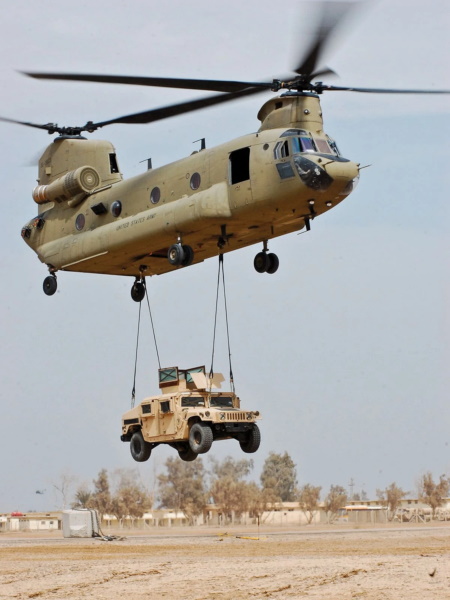
A prototype to demonstrate a "Block 2" upgrade to the CH-47F, mentioned earlier, was flown in 2019. The changes included:
The Block 2 upgrade also featured an "active feedback" control stick system. Previously, the Chinook stick had mechanical stops to prevent overstressing the airframe; the active feedback system introduced an "active parallel actuator system (APAS)" that replaced the fixed stops with "smart", electronically activated stops, allowing a pilot to push the flight envelope further. APAS was cheaper than a full fly-by-wire system, and could be retrofitted to older Chinooks.
Block 2 CH-47Fs are to enter service from 2023. Sketchy plans are already being made for a "Block 3" to follow, around 2027. The Army expects to keep the Chinook in service to 2060; by that time, it will have been in service for almost a century.
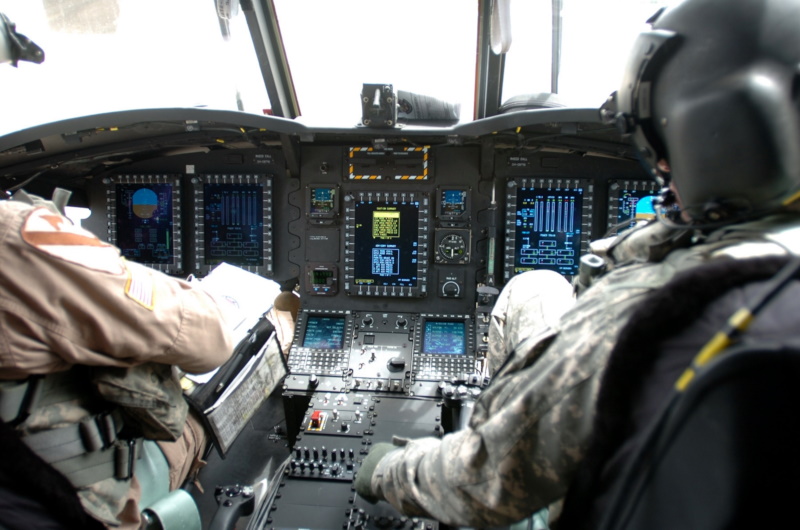
Orders for the CH-47F have also been coming in from export customers:
In 2011, the RAF ordered 14 "Chinook Mk.6" machines that were a variation on the CH-47F, with UK avionics as per Projects JULIUS, BAKER, and BENIC -- see above -- for compatibility with other British military Chinooks. Deliveries were in 2014 and 2015, with the UK military ending up being the second biggest Chinook user after the US Army.
The UK's 38 HC4 machines were upgraded to an "HC6A" standard, the primary change being replacement of the analog flight control system with the Boeing "Digital Automatic Flight Control System (DAFCS)" used on the HC6. The last of the HC6As was redelivered in 2021.
In 2021, the UK bought 14 CH-47F Block 2 Chinooks, optimized for special operations and to be designated "H-47 (ER)", to replace the oldest machines in Britain's Chinook fleet. Due to funding constraints, initial delivery was deferred to 2026.
BACK_TO_TOP* There were a number of interesting excursions from the main line of Chinook development. In 1965, Boeing modified four CH-47As to the "Armed CH-47A (ACH-47A)" gunship configuration. All cargo-handling gear was removed, while 900 kilograms (a ton) of armor and armament were added. Armament included:
The ACH-47A was given the name of "Guns A Go-Go" or "Go-Go Bird". Three of the four were evaluated in combat in Vietnam in 1968, but though the Go-Go Birds had impressive firepower, the Army judged that smaller and more maneuverable dedicated helicopter gunships like the Bell AH-1 Cobra were the way of the future, not flying battleships.
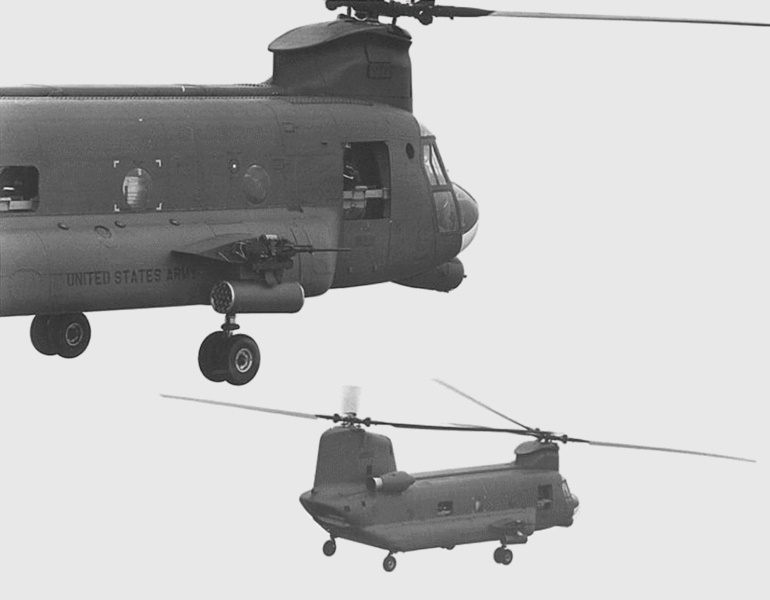
* One experimental machine, the "Model 347", was a prototype for a second-generation Chinook family. The program was initiated in 1969 and involved a rebuild of an existing CH-47A, featuring:
Initial flight was on 27 May 1970. The machine was later fitted with a fly-by-wire flight control system, and was run through evaluations for several years in the early 1970s.
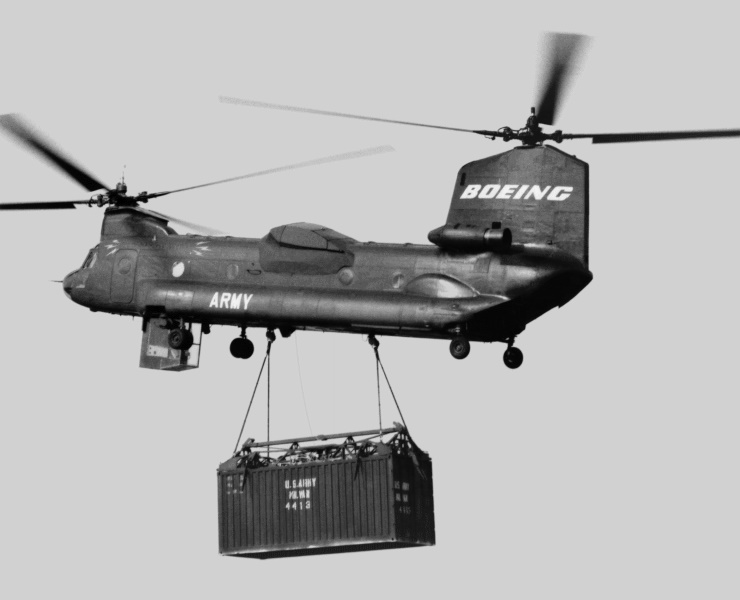
* While the Chinook is a big brute of a helicopter by American standards, it is dwarfed by the huge Soviet-Russian heavy-lift helicopters designed by the Mil organization, and for a long time Boeing and the US military had an urge to match or top the Mil heavy lifters. In the late 1960s, Boeing came up with designs for machines with broad similarities to the Sea Knight and Chinook, but about twice the size of the Chinook in terms of linear dimensions. Proposed machines included the "Model 227" transport and the "Model 237" flying crane.
Following award of an Army contract for a prototype of a "Heavy Lift Helicopter (HLH)" in 1973, Boeing began work on an oversized flying crane machine, the "XCH-62". It was to have a rotor diameter of 28 meters (92 feet), a fuselage length of 27.2 meters (89 feet 3 inches), and a footprint length of 49.5 meters (162 feet 3 inches). Its landing gear was arranged to allow it to pick up bulky cargoes, such as armored vehicles; it could carry twelve troops in its slender fuselage as well. Boeing also considered developing a commercial version, the "Model 301".
The XCH-62 prototype was in an advanced state of assembly in 1975, being readied for a planned initial flight the next year, when the US Congress cut funding for the program. The Sikorsky S-80 / CH-53E Super Stallion was felt to give adequate heavy-lift capability for US forces.
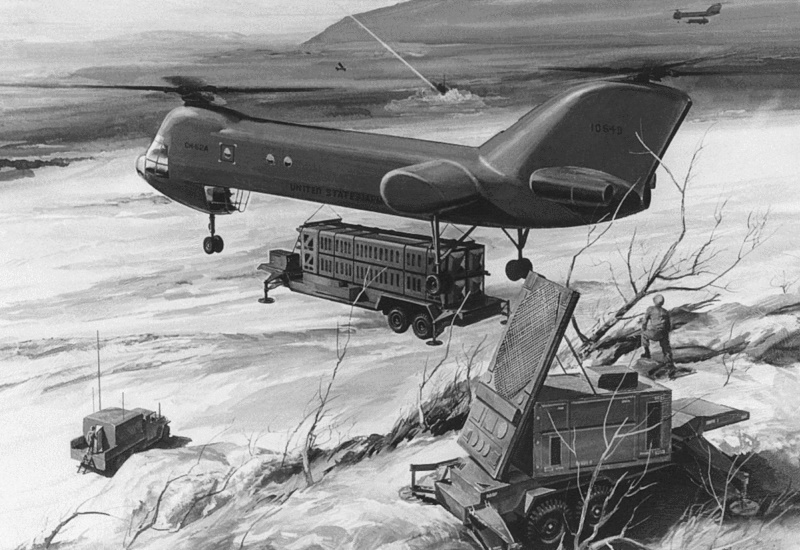
The incomplete XCH-62 prototype was mothballed, to be pulled out of storage in the mid-1980s when the Army, the US National Aeronautics & Space Administration (NASA), and the Defense Advanced Research Projects Agency (DARPA) collaborated on a scheme to finish the XCH-62 for experimental flights. However, Congress put their foot down again, and it didn't happen. It was a bit of a pity that such an impressive machine didn't at least perform trials -- though it is very hard to believe that, had it entered production, there would have been many commercial sales. The XCH-62 hulk sat idle at Fort Rucker, Alabama, until it was finally scrapped in 2005.
* In the 1980s, Boeing built an all-composite helicopter, the "Model 360", as a private venture to investigate new rotorcraft technologies. The Model 360 resembled the Sea Knight in a general way, but was more the size of the Chinook, and vastly more sophisticated and capable than either the Sea Knight or the Chinook.
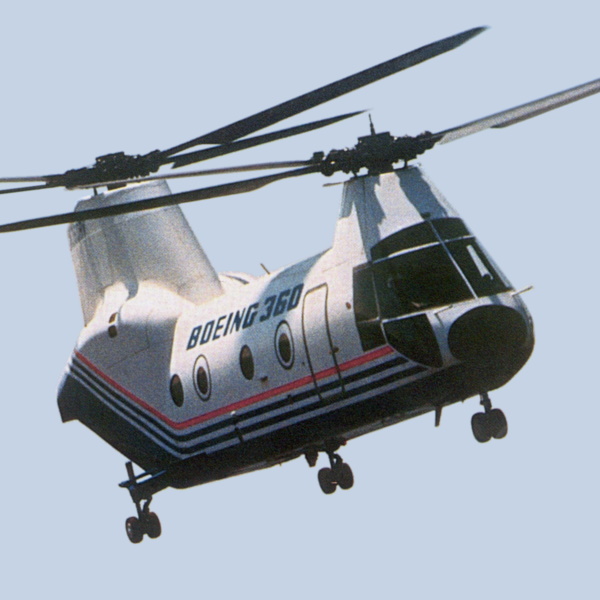
The Model 360 had a fuselage length of 15.5 meters (51 feet) long and a take-off weight of 13,835 kilograms (30,500 pounds). It was mostly built of composite materials, and featured a glass cockpit, with six CRT displays; a digital flight control system; twin Avco Lycoming AL5512 turboshafts providing 3,135 kW (4,200 SHP) each, driving four-blade composite rotors; and retractable tricycle landing gear. Cruise speed was 370 KPH (230 MPH).
BACK_TO_TOP* I was very familiar with the Chinook during my hitch in the Army down at Fort Hood, Texas, in the early 1970s. The distinctive slow and steady WHUMP WHUMP WHUMP sound of its rotor blades made it instantly recognizable by ear from the Hueys, Cobras, and Kiowas that buzzed around.
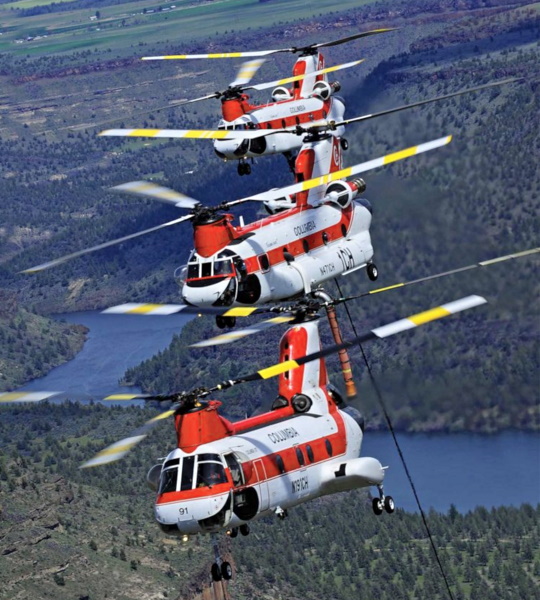
* Sources include:
I got a very nice writeup on details of the KV-107 in Saudi service from a Captain Orville B. Wolf, who had been a flight instructor for the Saudis on these machines and then moved up to a management position for the KV-107 fleet.
* Illustrations credits:
* Revision history:
v1.0.0 / 01 apr 02 v1.0.1 / 01 jul 02 / Comments on expansion of Army SOC CH-47 fleet. v1.0.2 / 01 jul 04 / General cleanup and update. v1.1.0 / 01 apr 09 / General update. v1.2.0 / 01 dec 09 / Split into two chapters. v1.2.1 / 01 aug 11 / Review & polish. v1.2.2 / 01 jul 13 / Review & polish. v1.2.3 / 01 jun 15 / Review & polish. v1.2.4 / 01 may 17 / Review & polish. v1.2.4 / 01 may 17 / Review & polish. v1.2.5 / 01 apr 19 / Review, update, & polish. v1.3.0 / 01 jul 21 / General clean-up, new illustrations. v1.3.1 / 01 oct 21 / Review & polish for e-book release. v1.4.0 / 01 sep 23 / Review, update, & polish.BACK_TO_TOP
